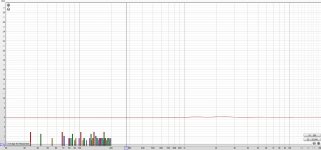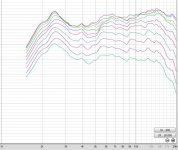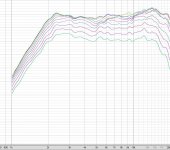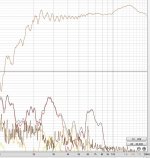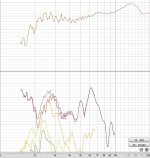This is a new one for me.
I'm designing a set of speaker using a Beston RT002A (the non-dipole version), I built the cabinets, measured the raw response of the drivers in the cabinets, then went to designing the crossover and painting the cabinets. I did a test fit/listen tonight and something didn't sound right, nor did they measure right. There's a ~5dB depression centered at 4kHz that's now there even if the crossover isn't connected, and it's present in both tweeters.
Anyone have any thoughts on what may be going on here?
I'm designing a set of speaker using a Beston RT002A (the non-dipole version), I built the cabinets, measured the raw response of the drivers in the cabinets, then went to designing the crossover and painting the cabinets. I did a test fit/listen tonight and something didn't sound right, nor did they measure right. There's a ~5dB depression centered at 4kHz that's now there even if the crossover isn't connected, and it's present in both tweeters.
Anyone have any thoughts on what may be going on here?
Attachments
Not much difference there to speak of, they are just about on top of each other.
To add another observation, I'm noticing that after painting the cabinet, the recess for the tweeters isn't as deep as it was before painting (paint build up on a rough surface), and the tweeters themselves are about 1/8" less recessed than they were before painting.
To add another observation, I'm noticing that after painting the cabinet, the recess for the tweeters isn't as deep as it was before painting (paint build up on a rough surface), and the tweeters themselves are about 1/8" less recessed than they were before painting.
Attachments
A difference of 1/8" of an inch isn't going to cause that much of a difference with regards to diffraction. These tweeters are horn loaded too so that should reduce diffraction effects even more.
I have no idea what's wrong with them.
The impedance plot might not be much diagnostic use with a tweeter like this though as they are basically a flat line.
The low end roll off of the tweeter is essentially identical to before implying that the sealed cavity behind the tweeters isn't amiss. Also the overall sensitivity is the same and as the roll off is the same that implies the overall basic function of the tweeter hasn't been affected.
What happens if you go off axis? I would be surprised if diffraction is causing this but something has to be. Try putting felt around the tweeter or make a quick and dirty test baffle out of cardboard or something where they are perfectly recessed. Heck add in a layer of cardboard to the front of the speakers to bring the tweeters flush with the baffle once more.
I have no idea what's wrong with them.
The impedance plot might not be much diagnostic use with a tweeter like this though as they are basically a flat line.
The low end roll off of the tweeter is essentially identical to before implying that the sealed cavity behind the tweeters isn't amiss. Also the overall sensitivity is the same and as the roll off is the same that implies the overall basic function of the tweeter hasn't been affected.
What happens if you go off axis? I would be surprised if diffraction is causing this but something has to be. Try putting felt around the tweeter or make a quick and dirty test baffle out of cardboard or something where they are perfectly recessed. Heck add in a layer of cardboard to the front of the speakers to bring the tweeters flush with the baffle once more.
Here's 0 to 90 degrees off axis. I tried acoustic foam on the baffle too, but it didn't do much of anything to speak of.
Both tweeters I have are showing the dip, and I did a full half-hemisphere of measurements on both of them without a crossover in addition to other general tests a month or two ago before the dip showed up yesterday, so I'm hoping that they haven't been damaged from my earlier measurements.
Appreciate all the ideas so far! Nothing like a puzzle that makes no sense...
Both tweeters I have are showing the dip, and I did a full half-hemisphere of measurements on both of them without a crossover in addition to other general tests a month or two ago before the dip showed up yesterday, so I'm hoping that they haven't been damaged from my earlier measurements.
Appreciate all the ideas so far! Nothing like a puzzle that makes no sense...
Attachments
I only ever did a sweep up from 1kHz up on them, but no, no blocking cap for the measurements. Measurement levels were always kept low, so I would have thought that damage would start showing up on sweep 2 rather than suddenly on sweep 40 with the crossover in place... although I did connect one node of the crossover incorrectly, so it's not like I'm above user erroring.
I forgot to mention in my last post that the two images are the before and after of one of the two tweeters in question.
I forgot to mention in my last post that the two images are the before and after of one of the two tweeters in question.
Questions-
This is in the speaker will full xover, right?
Are your coils in the woofer and tweeter networks close?
Are the coils placed/installed at orthogonal right angles?
Are you using litz-coils on your tweeters?
If they are not placed this way or are very close, options:
Separate the coils.
Flip a coil over.
Reposition them.
If you used litzes on your tweeters, swap to standard air-core.
I think your issue either lies in the capacitive nature of the litz coils causing the blemish, or that of coils coupling and causing a response aberration.
I've seen this before.
Later,
Wolf
This is in the speaker will full xover, right?
Are your coils in the woofer and tweeter networks close?
Are the coils placed/installed at orthogonal right angles?
Are you using litz-coils on your tweeters?
If they are not placed this way or are very close, options:
Separate the coils.
Flip a coil over.
Reposition them.
If you used litzes on your tweeters, swap to standard air-core.
I think your issue either lies in the capacitive nature of the litz coils causing the blemish, or that of coils coupling and causing a response aberration.
I've seen this before.
Later,
Wolf
The dip is present without Xover.
Check the foils thoroughly. Any conductive tracks looking wrinkled? You might have to open the units. Check your amp for DC output. Such ribbons are more prone to overload than regular domes. The conductors become too hot and the glue binding them to the foil releases.
I've been there (more than 30 years ago...) when I smoked Multicel 'supertweeters'. A few years later a house party destroyed my Technics TH400s. Both of the pairs did produce sound after the incidents, but not up to specs.
Check the foils thoroughly. Any conductive tracks looking wrinkled? You might have to open the units. Check your amp for DC output. Such ribbons are more prone to overload than regular domes. The conductors become too hot and the glue binding them to the foil releases.
I've been there (more than 30 years ago...) when I smoked Multicel 'supertweeters'. A few years later a house party destroyed my Technics TH400s. Both of the pairs did produce sound after the incidents, but not up to specs.
I'd measure the harmonic distortion. If these were damaged then I'd expect the HD to go to pot. Unless it is a leak. I mean daft suggestion but you don't have some global EQ applied to the output of your measurement system? Would explain a lot if this system is also the system that you listen to music on.
Funny you should mention global EQ because this is my "laboratory" system that I will apply EQ on for experimental purposes. So I double checked that, but it's set to flat.
Distortion profile has changed, I'm not sure if the microphone was the same distance in both measurements (always document your work, kids!), but the SPL at the mic is the same.
Distortion profile has changed, I'm not sure if the microphone was the same distance in both measurements (always document your work, kids!), but the SPL at the mic is the same.
Attachments
- Status
- This old topic is closed. If you want to reopen this topic, contact a moderator using the "Report Post" button.
- Home
- Loudspeakers
- Multi-Way
- What Happened To My Tweeters??

